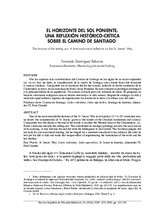El horizonte del sol poniente. Una reflexión histórico-crítica sobre el Camino de Santiago
The Horizon of the Setting Sun. A historical-Critical Reflection on the St. James' Way
Autor
Domínguez Reboiras, Fernando
Editor
UCOPressFecha
2016Materia
Camino de SantiagoCodex calixtinus
Sedes apostolica
Santiago en América
Alejandro VI
Paul Claudel
St. James’ Way
St. James in America
Alexander VI
METS:
Mostrar el registro METSPREMIS:
Mostrar el registro PREMISMetadatos
Mostrar el registro completo del ítemResumen
Uno los aspectos más característicos del Camino de Santiago en los siglos de su mayor esplendor
(ss. XII-XV) fue, sin duda, la consideración de la tumba de Santiago como límite físico del horizonte
y cosmos cristiano. Compostela era el santuario del fin del mundo, indicaba el límite occidental de la
Cristiandad, es decir, de los dominios de Roma hacia Poniente. En esto consiste su privilegio estratégico
y la principal fuente de su significado. Un camino al límite pero con voluntad de inicio. El peregrino no
buscaba curaciones milagrosas sino el retorno renovado a la vida normal, después de arriesgar su vida y
realizado aquel esfuerzo supremo de experimentar los límites de la tierra y la última raya del cielo. One of the most remarkable features of the St. James’ Way in its heyday (12th to 15th centuries) was,
no doubt, the consideration of St. James’ grave as the border of the Christian boundaries and cosmos.
Compostela was the shrine at the end of the world; it marked the Western limit of the Christendom, i.e.,
Rome’s domains towards the setting sun. This constituted its strategic privilege and was the main source
of its meaning: A way towards the end but with the willingness to start afresh. The Jacobean pilgrim did
not look for any miraculous healing, but he longed for a renewed comeback to his ordinary life after he
had put his life at risk and made that unique effort of experiencing the boundaries of the earth and the
last skyline.

